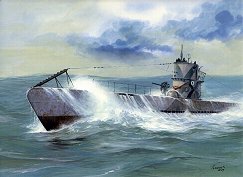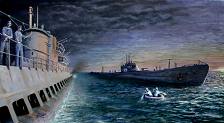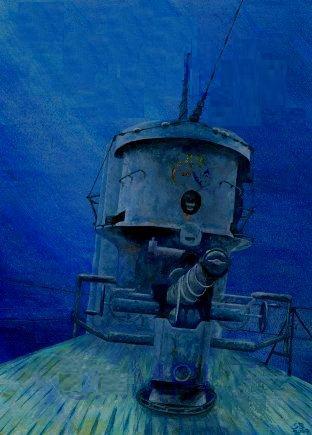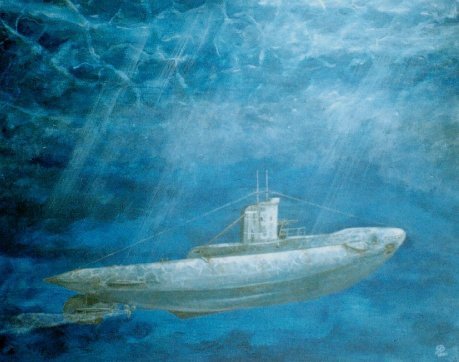back
to homepage &
photographs
Page 1. I
2. I
3. I
4. I
5. I
6. I
Tasks
6.
K13 SUBMARINE MEMORIAL – CARLINGFORD

In
1915 the British Admiralty secretly planned a class of submarines of
revolutionary design. These submersible destroyers, as they were called, were
to be the largest, heaviest and fastest submarines built anywhere in the world
at that time. Driven on the surface by steam engine, with a conning tower and
retractable funnels, they proved to be so fast that no British submarines
of the 1939-45 War could outstrip them.
Between August 1916 and May 1918 the
Royal Navy commissioned 17 of these vessels, designating them the
"K" class this design had been evolved out of fear that the German
Navy were building U-boats capable of 20 knots on the surface. The main
engines, two turbines fed by two oil-fired boilers producing 10,500 horsepower
and these were backed by four electric motors for underwater propulsion, plus
a 1,800 hp diesel unit for use on the surface while the boilers were building
pressure.
On
the morning of 29 January 1917 at 0800 hours, with 80 men on board, LCDR
Godfrey HERBERT RN gave out the order to cast off and tugs towed the giant
submarine K13 out of the basin of Fairfield’s yard to move
slowly down the Clyde. There was a crew of fifty three, plus fourteen
directors and employees of Fairfield’s, five representatives of
subcontractors, five Admiralty officials, a Clyde pilot, with two passengers
being the Commanding and Engineer officers of Submarine K14,
which was being built at the same yard.
K13
looked impressive, she was 339 feet long and displaced on the surface 1,800
tons, figures greater than those of the largest destroyers at that time. Her
submerged displacement was 2,600 tons. While the day before she had dived and
remained satisfactorily submerged in Gareloch for an hour. On the final test
drive a careful check of the dials and instruments showed everything
functioning correctly. One indicator was seen to be flickering, but this was
thought to faulty wiring and a bad contact. The indicator was vitally
important however. It showed whether the boiler room air ventilator lids were fully
shut before diving.

There
were in all nine watertight doors and apart from the torpedo hatches, twelve
hatches and innumerable valves, manholes and other openings in the hull:
"Too many damned holes", as more than one submariner observed.
But
on their final test dive, disaster struck, and for an incredible fifty-seven hours,
47 survivors were trapped in the submarine
after it sank. They were finally able to climb out through a hole cut in the
plating of the forward deck of the submarine. Against all odds they survived
in this tomb of death while what was described as bad salvage was carried out
above them with one botch after the next occurring. The final tally of
survivors was officially forty-eight with a loss of thirty-two lives. K13 was
raised to the surface six weeks after her fatal plunge and in mid March was
towed into Fairfield’s for refitting.
Some
months later, with minimal ceremony, she was re-commissioned into the Royal
Navy as K22. In the 16 years between 1917 and 1932 over 300 men
lost their lives in the K-class and all died as the result of accidents".
Why
therefore is a monument of K13 in Australia?
Here the facts
become hazy and take time to piece together. The story starts with Charles
Freestone.
Charles Freestone was born in Chelmsford, Essex, England in
1896, he had volunteered for Submarine service in the Royal Navy during the First
World War. He became a Leading Telegraphist on K13, and was one of the 47
survivors. Subsequently he
was transferred at his own request to HMA Submarines J3 and,
later, J4.
At the completion of the first World
War in 1919, the British Government gave Australia a gift of six J class
submarines and six navy destroyers. All the donated submarines were
commissioned into the Royal Australian Navy on 25 March 1919 at Portsmouth.
The submarines together with six navy
destroyers left Britain on the 9th April 1919 and arrived in Sydney on the
15th July 1919.

 J2
J2
The J Class subs and HMAS Platypus
Probably in Sydney Harbour as Fort Dension
appears to be in background. HMAS Platypus was the mother ship for the J class
submarines. It went on to serve in the 2nd World War long after the J Class
were scuttled. It withstood the Japanese air raids on Darwin and went out of
service in the 1950's. The Submarine base in Sydney is named in its honour.
When the J class were removed from service they were all scuttled (sunk) in
and around Port Phillip Bay Victoria. J3 was placed in shallow water as
a breakwater on the northern tip of Swan Island. The others of the class (J1,
J2, J4, J5 ) were all sunk in approx 30 to 40 metres of water about 2
kilometers off the mouth of Port Phillip Bay and are a popular scuba dive
site. (From David Patrick of Sydney, http://www.dropbears.com/w/ww1subs/jclass.htm)
The J4 was purchased by a Melbourne Salvage Company, and on the 6th December
1926 the J4 was successfully raised so it could be dismantled. The conning
tower of J4 was removed and erected on St.Kilda pier, as a starting tower for
the sailing club and was used until 1956. (http://home.vicnet.net.au/~maav/jsub2.htm)
When
Charles Freestone finished his service as part of the RAN (Royal
Australian Navy) he remained
in Australia. He was greatly attached to the Parramatta district where he
achieved outstanding success as a manufacturer, employer and investor. This
district reminded him of Chelmsford; both located on a river with large
industrial zones and pleasant rural areas surrounding them.

He
set aside part of his subdivision in Pennant Hills Road, Carlingford in 1956
to be named the "K13 Memorial Park". Without seeing the
Memorial commenced Charles died in May 1958. His health was impaired by
pneumonia and by long drawn out and exhausting battle with the authorities to
have his "Greenacres" property released from the Green Belt and
recognised as residential area. His wife then courageously took up her
husband’s dream.
During 1961, Mrs. M Freestone the widow of Charles, survivor of HMS K13,
paid for the building of a memorial in commemoration of those who have lost
their lives in K13 and other submarines. An architect was employed and while keeping in mind
Charles’ idea of using "good solid Australian stone as used by the
pioneers" to embody a seascape motif with the letters "K13"
prominently displayed, a plan was finally submitted to the council which was
adopted in March 1961.
Rear
Admiral H.A. SHOWERS CBE RAN (Rtd) conducted the service commemorating the
unveiling and dedication of the K13 Memorial to all Commonwealth submariners
on Sunday, 10 September 1961, in the presence of Mrs. M.F. FREESTONE.
Subsequently the Fourth Submarine Squadron of the Royal Navy and later RAN
held Squadron Divisions at the Memorial each year, which included
presentations of awards and wreath laying ceremony.



The
inscription on the memorial reads: "This memorial has been created in
memory of those officers and men of the Commonwealth who gave their lives in
submarines while serving the cause of freedom. It is called the "K13"
memorial in particular memory of those lost in HM Submarine K13."
Modified
from an article written
by Pauline Garland, the Librarian of the Submarine School Library, HMAS
PLATYPUS

Top